Are you ready to embark on a culinary adventure and impress your friends and family with a delicious Spanish dish? Look no further than classic paella! This iconic dish from the Valencia region of Spain is a flavorful medley of rice, vegetables, and succulent meats or seafood. In this step-by-step guide, ozinsight‘ll walk you through the process of making a mouthwatering classic paella from scratch. So put on your apron, gather your ingredients, and let’s get cooking!
Introduction
Before we dive into the cooking process, let’s take a moment to understand what classic paella is and its cultural significance. Paella is a traditional Spanish rice dish that originated in Valencia, Spain. It has become one of the country’s most popular exports and a symbol of Spanish cuisine worldwide. The dish typically consists of rice, saffron, vegetables, and a variety of proteins like chicken, rabbit, or seafood.
What is Classic Paella?
Classic paella is a beloved variation of the dish that follows the traditional recipe and cooking methods. It features a vibrant yellow rice cooked in a shallow, wide pan called a paellera. The combination of flavors and textures creates a truly delightful experience for your taste buds. The secret to a good paella lies in achieving the perfect balance of flavors and textures, and we’ll guide you through every step to ensure you get it right.
History of Paella
To truly appreciate classic paella, it’s essential to delve into its rich history. Paella has its roots in Valencia, where it was traditionally cooked by farmers and laborers over an open fire in the fields. The dish was often prepared with whatever ingredients were readily available, such as vegetables, snails, and rabbit. Over time, as paella gained popularity, different regional variations emerged, incorporating seafood, chicken, or other meats.
Ingredients for Classic Paella
To make a classic paella, you’ll need the following ingredients:
- Bomba or Calasparra rice
- Saffron threads
- Olive oil
- Onion
- Garlic
- Bell peppers
- Tomatoes
- Chicken or rabbit (optional)
- Seafood (such as shrimp, mussels, and squid)
- Paprika
- Spanish chorizo
- Green beans
- Artichoke hearts
- Chicken or vegetable broth
- Salt and pepper
Ensure that you source high-quality ingredients to elevate the flavors of your paella.
Equipment Needed
Before you start cooking, gather the following equipment:
- Paellera (a wide, shallow pan)
- Long-handled wooden spoon
- Chef’s knife
- Cutting board
- Measuring cups and spoons
- Kitchen timer
- Plate or aluminum foil (to cover the paella during resting)
Having the right equipment will make the cooking process smoother and more enjoyable.
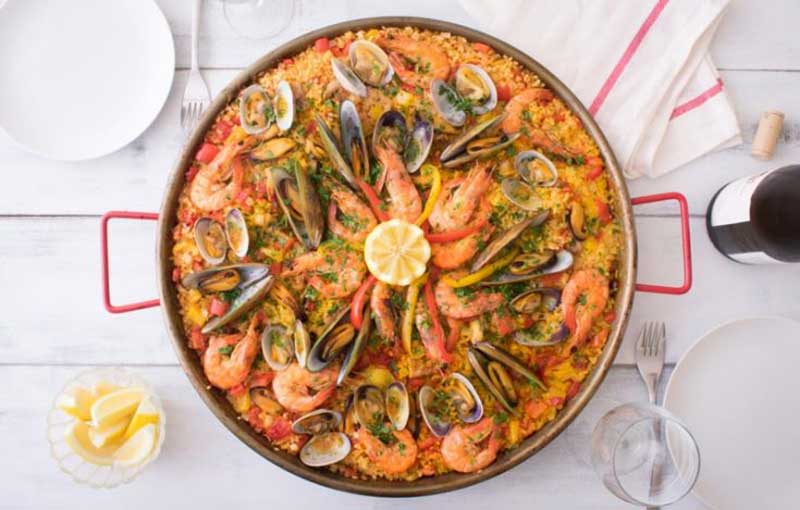
Step 1: Prepare the Broth
A flavorful broth forms the foundation of a delicious paella. In a separate pot, heat the chicken or vegetable broth until it reaches a gentle simmer. This step allows the broth to infuse with the flavors of the ingredients that will be added later. Keep the broth warm on low heat throughout the cooking process.
Step 2: Preparing the Ingredients
Proper preparation of the ingredients ensures even cooking and optimal flavors. Dice the onion, mince the garlic, chop the bell peppers, and peel and dice the tomatoes. If you’re using chicken or rabbit, cut them into small, bite-sized pieces. Rinse the seafood under cold water and pat it dry. Set aside all the prepared ingredients.
Step 3: Cooking the Sofrito
The sofrito is the flavor base of the paella and is created by sautéing onions, garlic, and tomatoes. Heat olive oil in the paellera over medium heat and add the diced onion. Sauté until the onion becomes translucent, then add the minced garlic and cook for another minute. Add the chopped bell peppers and tomatoes, and cook until the vegetables have softened and the flavors meld together.
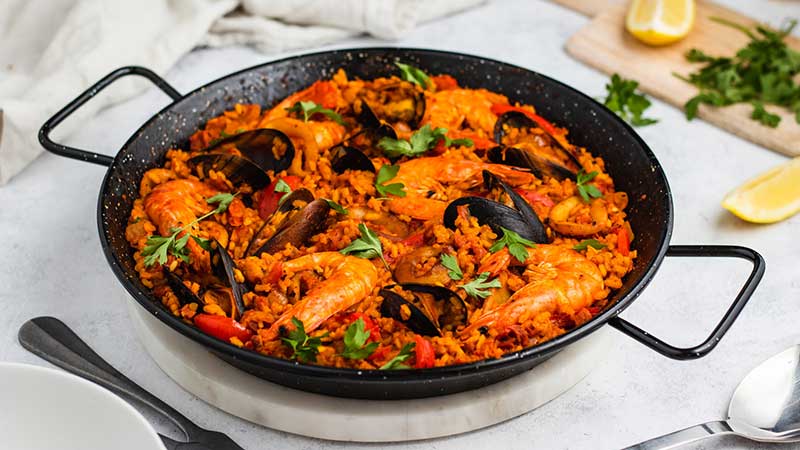
Step 4: Adding the Rice
Now it’s time to add the rice to the sofrito. Sprinkle the rice evenly over the sofrito, making sure it covers the entire pan. Gently stir the rice to coat it with the flavors of the sofrito. Add the saffron threads, paprika, and a pinch of salt and pepper. Stir everything together, ensuring that the rice is evenly distributed in the pan.
Step 5: Cooking the Paella
Pour the warm broth into the paellera, ensuring it covers the rice entirely. Avoid stirring the rice from this point forward to allow the characteristic socarrat (crust) to form on the bottom of the pan. Increase the heat to medium-high and let the paella cook for about 15-20 minutes, or until the rice is al dente. During this time, resist the temptation to stir, as it can disrupt the socarrat.
Step 6: Letting it Rest
Once the rice is cooked, remove the paella from the heat and cover it with a plate or aluminum foil. Let it rest for about 5-10 minutes. This resting period allows the flavors to meld and the rice to absorb any remaining liquid.
Step 7: Garnishing and Serving
Uncover the paella and garnish it with cooked seafood, chicken or rabbit (if using), green beans, and artichoke hearts. The vibrant colors and flavors of the garnishes add visual appeal and complexity to the dish. Serve the paella directly from the paellera, encouraging your guests to savor the communal dining experience that paella represents.
สรรพคุณของ มะระขี้นก หลายคนไม่เคยคิดอาการที่เป็นอยู่จะช่วยได้
Tips for Making the Perfect Paella
To elevate your paella-making skills, keep these tips in mind:
- Use Bomba or Calasparra rice for its ability to absorb liquid without losing texture.
- Infuse the broth with flavor by adding shells or heads of shrimp and a pinch of saffron.
- Avoid overcrowding the pan to ensure even cooking.
- Maintain a medium-high heat throughout the cooking process.
- Resist the urge to stir the rice once the broth is added.
Common Mistakes to Avoid
While making classic paella, it’s important to avoid these common pitfalls:
- Using the wrong type of rice that can turn mushy or lose texture.
- Stirring the rice once the broth is added, which can result in a sticky paella.
- Overcooking the rice, leading to a mushy consistency.
- Overcrowding the pan, preventing the rice from cooking evenly.
- Neglecting the resting period, which allows the flavors to meld together.
By keeping these tips and avoiding common mistakes, you’ll be well on your way to mastering the art of making classic paella.
Conclusion
Congratulations! You have successfully learned the step-by-step process of making a classic paella. From preparing the broth to adding the final garnishes, each stage plays a crucial role in creating a delicious and authentic paella. Remember to use high-quality ingredients, follow the traditional techniques, and have fun with the process. With practice, you’ll be able to impress your loved ones with your own unique twist on this iconic Spanish dish.
Frequently Asked Questions
Can I substitute the rice in paella with another type of grain?
While rice is the traditional grain used in paella, you can experiment with other grains like quinoa or couscous. Keep in mind that the cooking times and liquid ratios may vary, so adjust accordingly.
Can I make paella without seafood or meat?
Absolutely! Paella can be customized to suit different dietary preferences. You can create a delicious vegetarian paella by using a variety of vegetables and flavorful spices.
Can I make paella in a regular frying pan or skillet?
Although a paellera is ideal for making paella, you can use a large, shallow frying pan or skillet as an alternative. Just be mindful of the pan’s size and ensure even heat distribution.
Can I freeze leftover paella?
While it’s possible to freeze leftover paella, the texture of the rice may change slightly upon reheating. It’s best to consume paella fresh for the most enjoyable experience.
Are there regional variations of paella in Spain?
Yes, paella has evolved into various regional variations in Spain. Some popular examples include seafood paella (paella de mariscos) from the coast and mixed paella (paella mixta) with both meat and seafood.




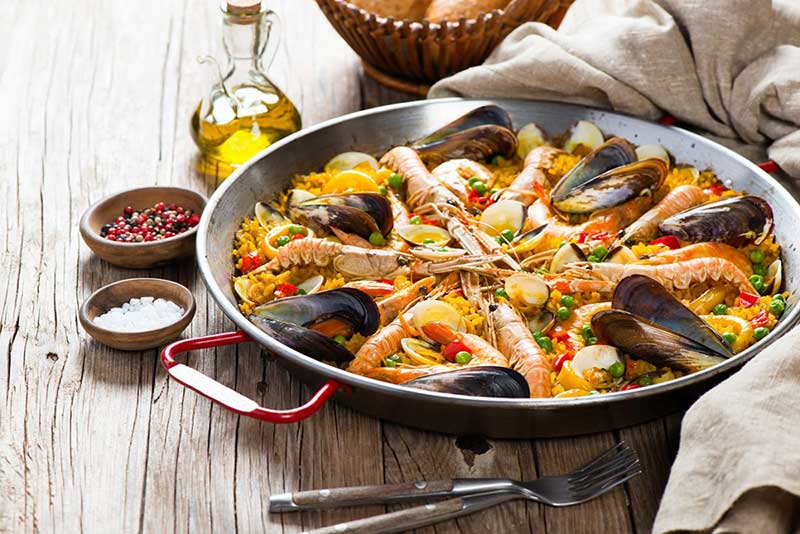
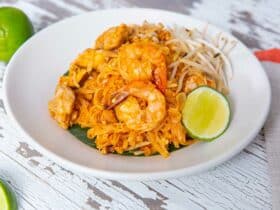

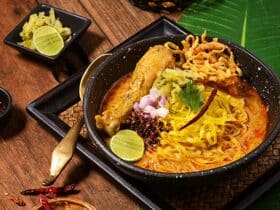

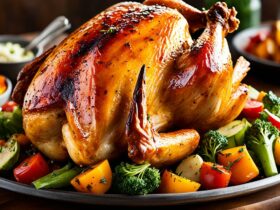

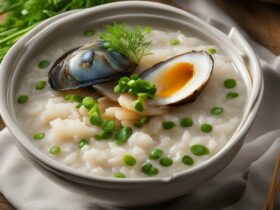
Got a Questions?
Find us on Socials or Contact us and we’ll get back to you as soon as possible.